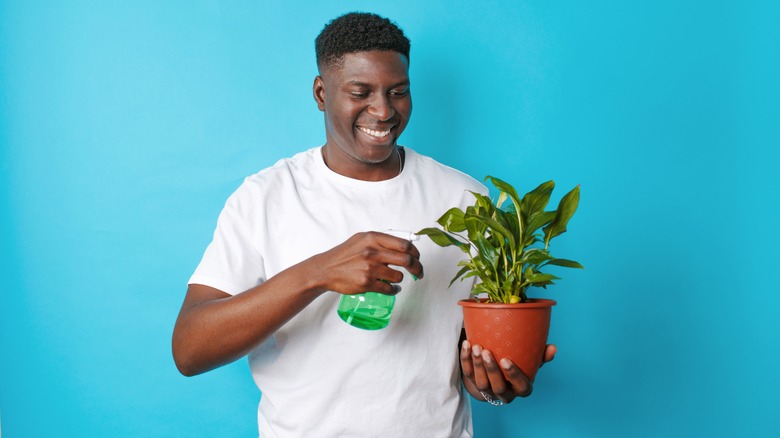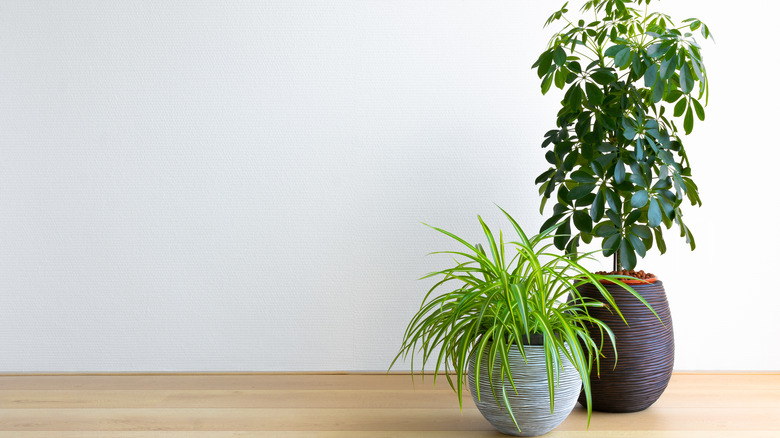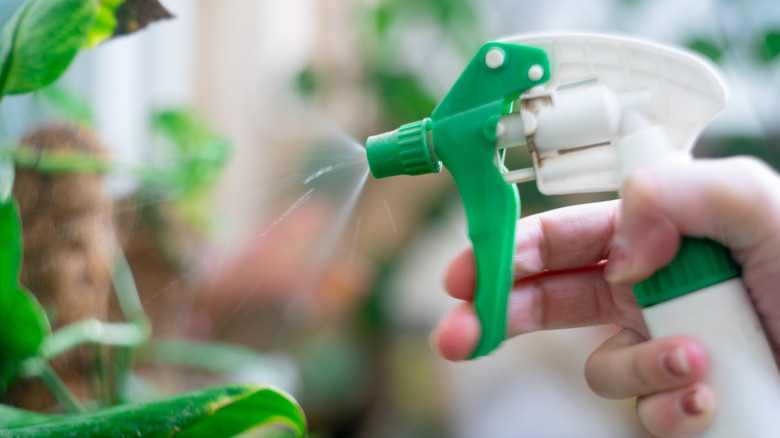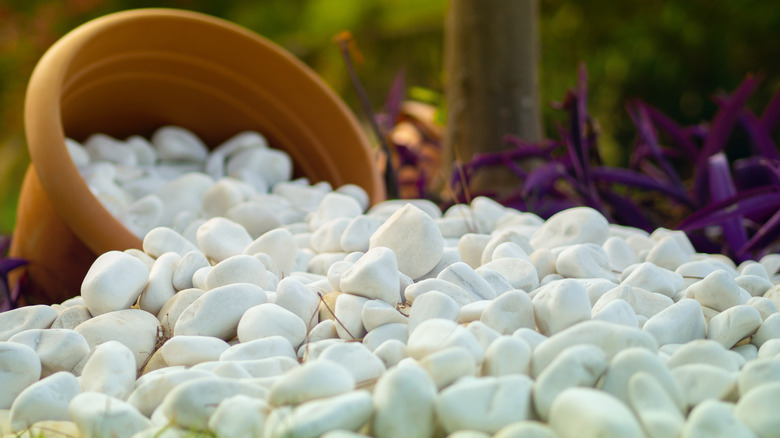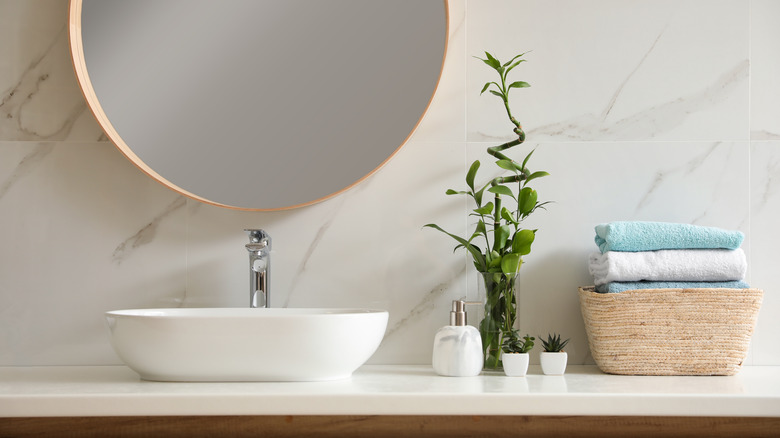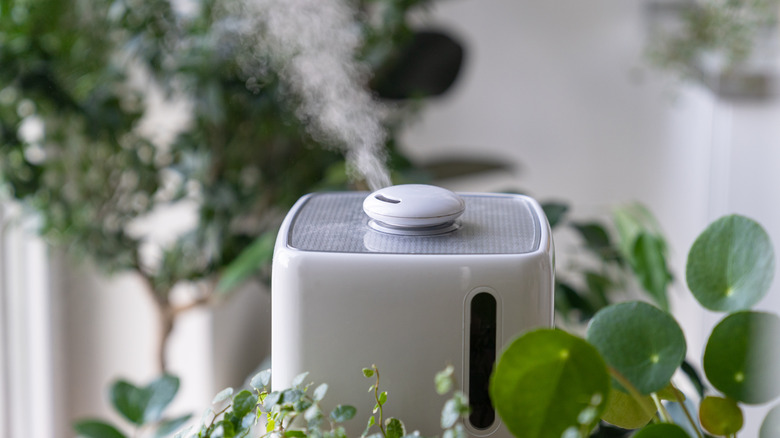How To Raise The Humidity In Your Home So Your Favorite House Plants Can Thrive
After years of being overshadowed in popularity by artwork and trinkets, houseplants are finally gaining back their popularity in the home décor market. According to a survey by Civic Science, 66% of respondents said they own at least one houseplant — a statistic that has been steadily increasing since 2019. If you hopped on the trend and filled your home with the gorgeous leaves of tropical species, however, you may find yourself facing a new issue as the winter weather rolls in.
Many plant varieties thrive in humid climates, but winter air and constantly running the heater can drain the moisture from your space. According to WebMD, cooler air holds less water than warmer air. You may notice this change first in your own skin and sinuses, but your plants could be feeling it, too, exhibiting signs like drooping, yellowing, and brown edges on their leaves. Keep reading to learn how to keep your plants from feeling that trademark winter dryness and increase the humidity in their spaces so they can thrive.
Create a microbiome
Creating a microbiome may sound a bit intimidating, but not to worry. The process is so simple you may already be doing it without knowing. Plants release water vapor through their leaves through a process called transpiration — this helps them maintain equilibrium with the environment and get rid of any excess that may leave them waterlogged (via Byju's). Because plants increase humidity in an area on their own, grouping a few together almost creates a little bubble of humidity, also known as a microbiome.
This method can work with as many cultivars as you want; just make sure all of them prefer a bit more humidity. Plants that naturally grow in warm, arid climates, like succulents, can thrive alone, but with tropical varieties like the ever-popular monstera and pothos, a little grouping can go a long way. If you want to take it one step further, you can also place a small dish of water somewhere in the mix. It will naturally evaporate over time, adding an extra boost of humidity to the air.
Mist the plants
To quickly add a little moisture, consider misting your plants. They absorb water through both their roots and their leaves, so a simple spritz with distilled or rainwater along the top and bottom of the leaves is a great way to give them an extra boost of hydration while also increasing the humidity of the surrounding air. According to Urban Garden Gal, tropical plants thrive with a bit of mist, but it's important to consider if yours is a candidate before reaching for the spray bottle.
Succulents and desert plants will likely thrive in the low humidity of your home in the winter, so adding more water through misting isn't necessary and could even lead to overwatering and rot. Keep an eye out for your plants with fuzzy leaves, as well. The textured leaves on varieties like African violets and iron cross begonias can trap moisture, and too much water can cause decay.
Use a pebble tray
Adding moisture to the air surrounding a plant without actually overwatering it can be difficult, but there's a simple solution: pebbles. Anything from decorative glass beads to leftover aquarium rocks can work for this DIY, so make sure you dig through your cabinets before heading to the store.
According to The Leafy Little Home, all you need to do is grab a dish that fits your plant's pot, fill it with pebbles, glass beads, or gravel, and add a layer of water that sits just below the surface of the rocks. From there, flatten everything out and place the plant in the dish. The pebbles allow the cultivar to sit on top of the water but not touch it, giving it a chance to bask in the natural humidity from evaporation without absorbing too much moisture through the base of the pot. Periodically check the water level and add more if it dries out; just make sure not to completely submerge the pebbles.
Place the plant in a humid room
While you may enjoy displaying your plants in your living room, transferring them over to the more humid rooms in your home can help them thrive while the heater is running through the winter. Typical home humidity runs around 30%-50% (via HVAC), while the tropical areas that many houseplants originate from are closer to 70%-90% (via Cielo). Upping the rest of your home to the humidity levels of a rainforest might make your plants happy, but it can lead to issues with mildew and mold and leave you feeling sticky and uncomfortable.
Instead, bring them into areas like the bathroom, kitchen, and laundry room that naturally have higher levels of moisture in the air. Here, your morning shower or boiling pasta water can bring some benefits to your plants without any change in your daily routine while also adding a splash of greenery to some of the most used spaces in the home.
Get a humidifier
Yes, this one is obvious, but humidifiers are popular for a reason. According to How Stuff Works, typical home humidifiers work by releasing water vapor into the air, either by boiling water to create steam or using ultrasonic frequencies or a diffuser to release cool water droplets. They're a cold and flu season staple because they help rehydrate mucous membranes and prevent bloody noses and sore throats, but they can also be used to create the proper environment for your plants.
If you have a humidifier on hand, it's great to bring out if you notice any crusty leaves, but it also makes a solid investment if you find yourself feeling parched during the colder months. Of course, plants thrive with a little extra humidity, but so does just about every other living thing. All these methods help bring a bit of moisture back into the home, meaning benefits for both you and your tropical plant babies.
